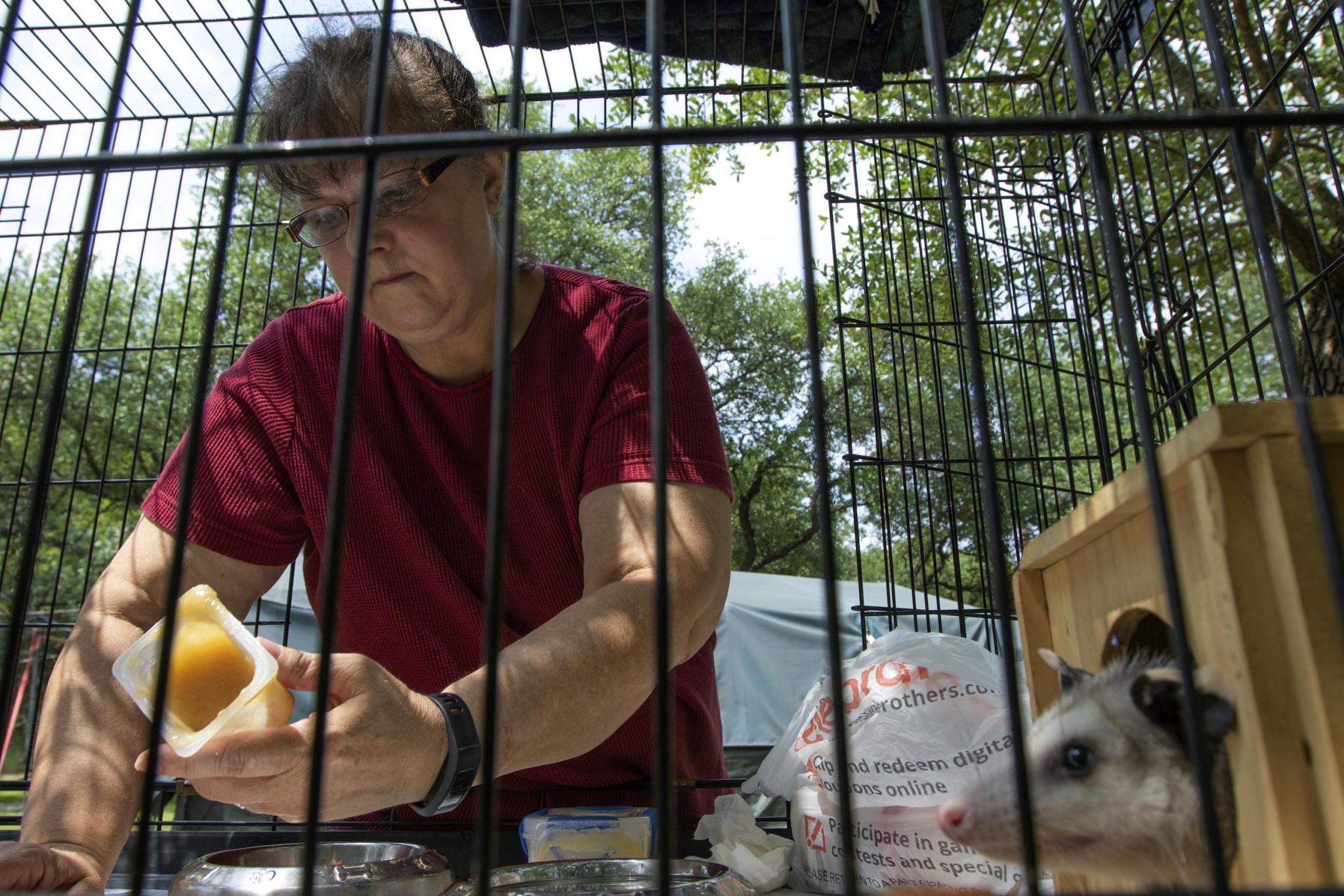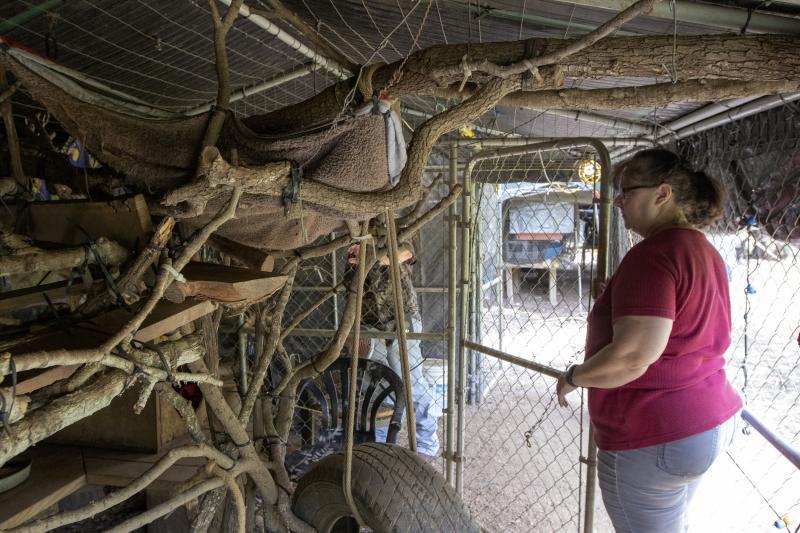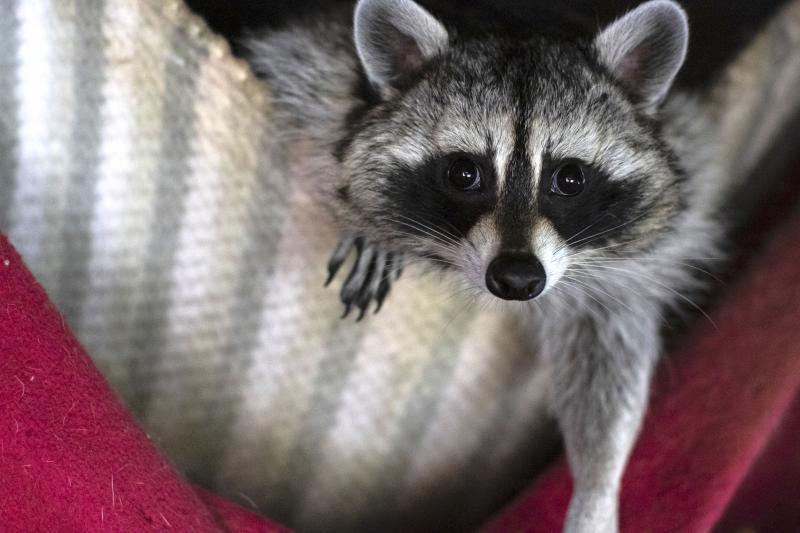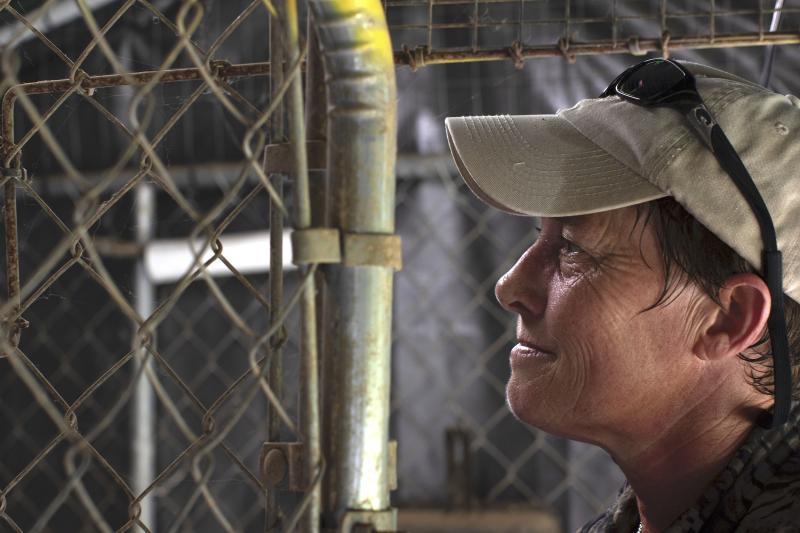
Drift Inn Wildlife Sanctuary: Aiding Mother Nature
Mother Nature, especially in Central Texas, can be indifferent and even catastrophic at times, but with residential areas constantly expanding in the state, those that depend on her, like the native wildlife of the Hill Country, are becoming increasingly vulnerable to human interaction and intervention. But there are those, like the volunteers and permitted wildlife rehabilitators that run the Drift Inn Wildlife Sanctuary, that are working to rehabilitate and release orphaned, injured and displaced wildlife.
The Drift Inn Wildlife Sanctuary is a nonprofit that helps orphaned, injured and displaced members of the native Texas wildlife population. Adult deer hit by cars, orphaned opossums, fawns and squirrels, bobcat babies whose mothers have been shot by hunters, and raccoons caught in traps are just a few of the situations that bring animals to their nursery.
Jean Clifton and Beth Young, both permitted rehabilitators at Drift Inn Wildlife Sanctuary, have worked with the organization for 9 years. Both Clifton and Young are retired Austin Police officers. After they retired from the force, each with 22 years, they started doing dog rescues around Central Texas. It wasn’t until a neighbor called them one night asking if they could help with a possum that was lying hurt in the middle of the road, that they delved into rescuing wildlife.
“We went and we got the possum and we started looking for a permitted rehab — and by permitted I mean someone that was permitted by the Texas Parks and Wildlife Department, that has been trained and can legally rehabilitate wildlife,” Young said.
That is when they met Kim Johnson, who started the Drift Inn Wildlife Sanctuary over a decade ago.
“We were very lucky to find Kim Johnson,” Young said. “Kim told us to bring the possum over, so we took it to her and that’s when we got to talking to her about wildlife rehabilitation.”
Clifton and Young decided to join Johnson on her mission and started training with her to be permitted Texas Parks and Wildlife wildlife rehabilitators.
Young said there are some common situations that bring animals to them and education on how to handle the situation can mean the difference between life and death for the animal as well as the difference between safely handling an animal and getting hurt by it.

Feeling secure hidden by a tree branch zip tied to the enclosure, Rudy pokes his head out of his box to eat.
Noises in the Attic?
One of the most common occurrences that Young receives calls about are animals taking up residence in people’s homes, especially attics. Wildlife taking up residence in attics, under porches and even in walls, usually starts happening in April, or “baby season” for most wildlife.
Young said the first thing to note is whether the animal is nocturnal or diurnal — is there more movement during the day or at night? But don’t get out that live animal trap just yet. Young said people after hearing noises will often set a trap and only trap the mother, unaware that there are also babies. This removes the mother from her babies and often results in the babies death or their scrambling around when they start starving without their mother.
Young says they suggest if a raccoon or squirrel move into the attic in the spring, give them a couple of months and when the mother takes them out on her own, then go in and board up any holes they could get in through. Winter is the best time, according to Young, to board up and secure any possible entry points for wildlife into attics.
“Most of the time it's raccoons or squirrels and usually — the larger part of them are raccoons — they only take their babies up there in order to rear them for a couple of months and then they move them out,” Young said. “They don’t really want to live in your attic around humans; they just want a safe place to rear their babies.”
If the animal must be moved out, Young said, that wildlife can be humanely evicted by putting a bright light and a radio playing talk radio in the inhabited area. Then Young advises placing flour over the opening in the attic to ensure they are leaving the attic. It takes several trips for a mother to move her babies out, so seeing prints doesn’t mean they are necessarily gone, Young said. So continue to check it daily until prints are not detected on fresh flour for several days. The attic can then safely be boarded up after a final check for remaining wildlife.
“No matter what, if your boarding up an attic, under a deck or anywhere else, you want to check that not only is the mom out of there but all of her babies as well,” Young said.

Young inspects the covered enclosure housing one of the facility's animal ambassadors, Shakey the raccoon. Unlike most animals, Shakey is a permanent resident due to a disability.
Helping Abandoned Wildlife
Young said most people want to help wildlife, but sometimes human intervention does more harm than good.
“The two scenarios that we run into the most,” Young said, “is fawns and rabbits. Not necessarily because they’re hurt, but because people find their babies alone. The interesting thing is that none of these animals understand that they are in human territory when they do this; they’re only doing what is natural for them and what seems unnatural to us.”
Rabbits and fawns both often leave their babies alone during the day, when they are typically safe from predators, to forage for food. According to Young, rabbits only feed their young twice in a 24-hour period — usually before the sun comes up and after it goes down. They also often stay away from their young to not attract predators.
“We often have people that call about abandoned babies, and we find out about the circumstances and it’s not that they found the dead mom, they just saw baby rabbits and thought that they shouldn't be by themselves, but that is the natural thing for rabbit moms and it’s the same for deer and their fawns,” Young said. “Deer often give birth near people’s or in people’s front yards or backyards and people call when they don’t see the mother around.”
This situation often leads to what Young calls “Deer-knapping,” because people assume if they see a baby alone it is abandoned. But deer leave their babies for up to 14 hours at a time to forage for food and rebuild their milk supply.
“People often think they are doing something good and they mean to, but once they describe them and we know how small the fawn is, we ask them to put them back exactly where they found them,” Young said. “It is also a myth that the mothers won’t come back if you touch them. The mothers will come back.”
Unless the fawn is in immediate danger — in the middle of the road, obviously sick or injured or covered in fire ants — it is recommended to leave them be, according to Young.
“Now there are times where something has happened to the mother or she hasn’t left them in a good place,” she said. “If the fawn, or any animal, has ants or flies on them, that is not a good sign, then you should go ahead and call an animal rehabilitator.”
If it is in immediate danger, pick it up, remove ants if that is the case, wrap it in a towel and place in a quiet, safe place until a rehabilitator can be contacted.
Young said no matter what animal you pick up, whether adult or infant, do not feed them and do not water them until a permitted wildlife rehabilitator has said it is OK to do so.
“The reason for this is because, depending on what their individual situation is, it could kill them to provide them with food or water,” Young said. “Get ahold of us first and we can guide you. Because in most cases the animal needs to be warmed up, given fluids — sometimes subcutaneous fluids — before they can eat anything. It could shock their system and they could die.”
Baby birds often fall into a similar situation as fawns and baby rabbits; people find them on the ground and assume they fell from the nest, but Young said that isn’t always the case.
“Mother birds truly do push their babies out of their nest to teach them how to fly,” Young said, “and different species teach their young differently. Some birds learn to fly from the ground so the mother or even the father will be watching them from not far away.”
Young said there are times to intervene, for instance, if the bird has ants or flies on it or if the bird has no feathers, it most likely fell out of the nest. In those cases, it is ok to carefully pick up the baby bird, remove any ants, check for injury and, if possible, place it back in the nest. It is also a common myth that mother birds will abandon their young if touched by a human.
If the bird is injured and can’t be returned to its nest and requires care. The next step is to call a permitted wildlife rehabilitator. Drift Inn Wildlife Sanctuary does not accept birds but will assist in finding an appropriate rehabilitator. Texas Parks and Wildlife also has a list of permitted rehabilitators.
If a baby squirrel has fallen out of its nest, there could be several reasons, one being that its mother has been killed and the babies are starting to get hungry and moving around looking for food the other is that the squirrel simply fell out of its nest.
If you find a baby squirrel, Young said, the first step is to make sure before taking it to a rehabilitator that its mother is actually gone. This can be done by placing the baby squirrel with a cloth in a an open cardboard box off the ground or safely perched on a lower branch of the tree it fell out of.
“Often the squirrel mothers will come and get them,” Young said. “But if they are still there hours later we may ask you to bring them to us. Squirrels are diurnal, so if the baby is still there after dusk, then it’s time to pick them up and get them to us.”
A raccoon, named Lucy, hangs out of her hammock on the Sanctuary's porch.
Basic Care of Wildlife
Most animals that require rehabilitation will require warming up as one of the first steps of stabilizing them. Young said the easiest way to go about this is by wrapping the animal in a cloth — preferably something that doesn’t have thread loops like terry cloth, so that claws and talons can’t get caught. And then place the animal with the cloth in a cardboard box — a shoebox works well — with holes in it. Then shut the box and get them to a rehabilitator as soon as possible.
“This works in keeping their body temperature up or if they are cold, getting their body temperature back up to where it’s supposed to be,” Young said.
Young doesn’t advise using a heating pad unless specifically instructed to by a rehabilitator.
“If they put an animal that can’t move on a heating pad, they can overheat, even burn, and they’ll dehydrate and they can die of that,” Young said. “It’s a case-by-case basis.”
Young's partner Jean Clifton watches as a raccoon, named Shakey, settles back into his hammock.
Rabies-Carrying Species
Rabies-carrying species in the area include bats, fox, skunk, raccoon and coyote. But some species that are often mistaken as rabies carrying species are armadillo and opossum, which can’t carry the disease and actually repel and eat other pests like black-legged ticks that carry Lyme disease.
“Opossum and armadillo don’t carry rabies, now they can have other issues, but that isn’t one of them,” Young said. “They are very beneficial because they eat so many things like ticks and they keep rodents away. But both these species are extremely beneficial, as are bats, which eat so many mosquitoes.”
Young said many think seeing bats in their residential neighborhoods is cause for concern because of the potential for carrying rabies, but bats in general are very beneficial to the local ecology and even beneficial for human populations because bat’s predation on mosquitoes helps regulate vector diseases like Zika and west nile virus.
Young said the only time to be concerned about a bat is if it can be seen flopping around on the ground or seems disoriented, then it is time to get in contact with a bat conservation group.
Young said to never handle a bat with bare hands and recommends contacting the Bat Conservation International located in Austin at 512-327-9721 or calling a game warden at 512-389-4848 if a bat is potentially hurt or infected with rabies.
Young said people that see foxes or raccoons during the day often assume the animal has rabies, as they are typically nocturnal species, but that isn’t necessarily true. Foxes are actually cathemeral, meaning they are active during the day and night.
“If they are doing something odd like chasing their tails in circles or falling down or laying in an open space for a prolonged time, then something may be wrong,” Young said. “But just seeing a fox or a during the day is no reason to be alarmed.”
The Drift Inn Wildlife Sanctuary is not permitted to transport or rehabilitate coyotes or foxes, both of which are under statewide rabies quarantine. They recommend contacting the Texas Department of Health Zoonosis Control Division at 512-458-7255 or calling a game warden at 512-389-4848 if a fox is suspected to be rabid or injured.
Young said during mating season, some animals that are typically nocturnal will become active in the daytime and seeing them during the day is not a cause for concern.
“Raccoons and skunks and other animals you typically see at night, during springtime it’s common to see them during the day because they are going to forage during the day, while it’s safest for their babies to be alone,” Young said. “Then they will go back to their nest and stay there all night long to protect their babies from predators.”
If the raccoon or skunk is noticeably injured or sick though, Young said to contact the Drift Inn or another local rehabilitator immediately. Adult raccoons can be dangerous, so do not attempt to pick up the animal without protection or, if at all possible, to not attempt to rescue until a rehabilitator or the game warden has been contacted for assistance.
At the end of the day, Young said, humans can be the most detrimental thing to wildlife because of the increased presence of humans in their territories and their increased acclimation to living in residential and urban areas.
“As we’ve cemented and concreted, taken trees down and put our homes in places, we’ve moved animals out. And the more of a concrete world we build, the less natural areas they have. So they are acclimating to towns and residential neighborhoods because they have no other choice — their species will either acclimate or die out. And wildlife is extremely resilient and so they have acclimated, and so you are going to see them more because we’ve taken away their natural habitat.”
Drift Inn Wildlife Sanctuary is a 501c3 nonprofit. They can be reached 24 hours a day, 7 days a week at 512-971-1260, 512-731-9386 or 512-608-3262. Donations can be made to their organization by cash, check and gift cards. They also have a wishlist on their website of needed items that can be sent or taken to the sanctuary at 101 Highpoint Dr. in Wimberley or their business office at 167 Oak Vista in New Braunfels. For more information go to the Drift Inn's website.













